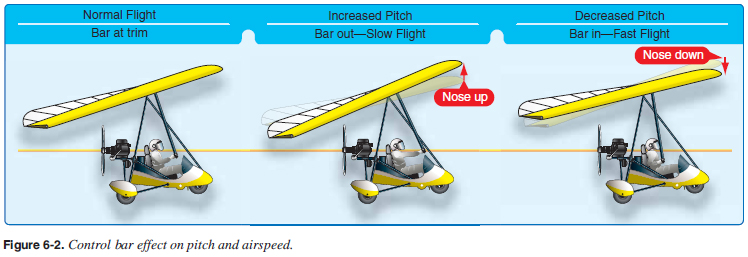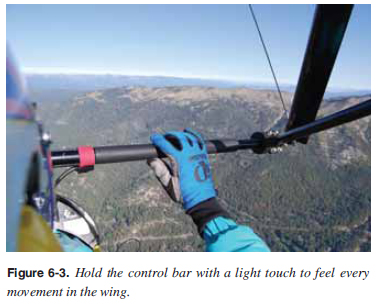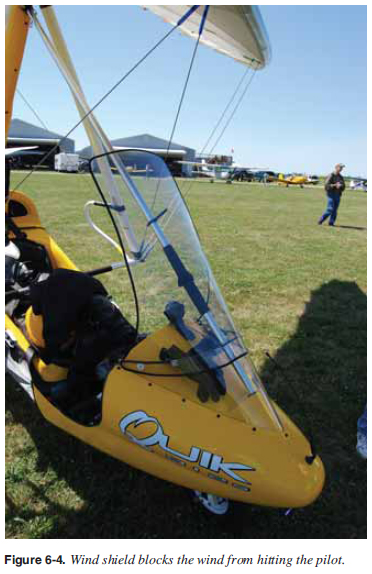
 |
|
||
| CHAPTER 6. Flight Manuevers
Effects and the Use of the Controls In using the fl ight controls, the results should be looked at in relation to the pilot. The pilot should always be considered the center of movement of the aircraft or the reference point from which the movements are judged and described. The important concept and a foundation for all fl ight maneuvers is not to think of the controls in terms of “up” or “down” in respect to the Earth. This is only a relative state to the pilot. Controls need to be thought of in relation to the pilot, so that the control use can be for any fl ight attitude whether climbing, diving, banking, or a combination of these. Sideways pressure applied by moving the control bar to the left lowers the right wing in relation to the pilot; moving the control bar to the right lowers the left wing in relation to the pilot. This is roll control as discussed in Chapter 2, Aerodynamics. [Figure 6-1]  Pushing and forward pressure applied to the control bar results in the WSC aircraft’s nose rising in relation to the pilot slowing down the WSC, while pulling in or back pressure results in the nose lowering in relation to the pilot increasing speed of the WSC. At the same trim speed, increasing the throttle results in the nose remaining at the same level in relation to the pilot but raising pitch with increased throttle and lowering pitch with decreased throttle in relation to the Earth’s horizon. Both control bar and throttle effect pitch in relation to the earth’s horizon. This is pitch control, as discussed in Chapter 2, Aerodynamics. [Figure 6-2]  Feel of the Aircraft All WSC aircraft controls have a natural “live pressure” while in fl ight and will remain in a neutral position of their own accord if the aircraft is trimmed properly. The pilot should think of exerting a force on the controls against this live pressure or resistance. It is the duration and amount of force exerted on the control bar that affects the controls and maneuvers the WSC aircraft. The actual amount of the control input is of little importance; but it is important that the pilot maneuver the aircraft by applying suffi cient control pressure to obtain a desired result, regardless of how far the control bar is actually moved. The controls should be held lightly, not grabbed and squeezed. A common error for beginning pilots is a tendency to “tightly grip the bar.” This tendency should be avoided as it prevents the development of “feel,” which is an important part of aircraft control. [Figure 6-3]  However, for WSC aircraft, the controls do need to be gripped during moderate and severe turbulence to make sure the wing does not get ripped out of the pilot’s hands. This is why fl ying a WSC aircraft in turbulence requires strength and endurance. It can be fatiguing if the pilot is not used to or in shape for this type of fl ying. The initial fl ight training should be done in calm conditions so the student can use a soft touch on the controls to develop the feel for the WSC aircraft. The ability to sense a fl ight condition is often called “feel of the aircraft,” but senses in addition to “feel” are also involved. Sounds inherent to fl ight are an important sense in developing “feel.” The air that rushes past an open fl ight deck can be felt and heard easily within the tolerances of the Practical Test Standards (PTS) of ± 10 knots. When the level of sound increases, it indicates that airspeed is increasing. In addition to the sound of the air, air rushing past is also felt unless an effective wind screen is placed in front of the pilot blocking the wind. [Figure 6-4]  The powerplant emits distinctive sound patterns in different conditions of fl ight. The sound of the engine in cruise fl ight sounds different from the sound in a glide or a climb. Overall, there are three sources of actual “feel” that are very important to the pilot.
Kinesthesia, or the sensing of changes in direction or speed of motion, is one of the most important senses a pilot can develop. When properly developed, kinesthesia can warn the pilot of changes in speed and/or the beginning of a settling or mushing of the aircraft. The senses that contribute to “feel” of the aircraft are inherent in every person. However, “feel” must be developed. It is a well established fact that the pilot who develops a “feel” for the aircraft early in fl ight training has little diffi culty with advanced fl ight maneuvers. |
| ©AvStop Online Magazine Contact Us Return To Books |